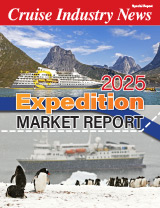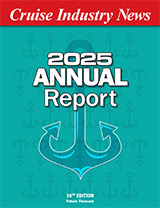Cruise lines can be extremely profitable, according to Mark McVicar an industry analyst at County Nat West. The share prices of Carnival Cruise Lines and Kloster Cruise have doubled and trebled since the crash of 1987, he said, emphasizing that this by far exceeds the average recovery of the stock markets.
Trygve Hegnar, Chairman and CEO of Kloster Cruise, said that there is no industry capable of generating profit margins comparable to the cruise industry. He pointed out that Kloster Cruise with record net earnings of $18.5 million in the first quarter had a 20 percent profit margin on income from operations.
Growth Industry
“The cruise lines came through the market good shape,” McVicar said. “The cruise lines are still a small but emerging part of the leisure industry, and the market is discovering that they are delivering relatively reasonably priced vacations.
“The market support is strong,” McVicar said, “in spite of fluctuations in the economies, we don’t believe that people will give up their vacations that easily. And there is a lot of investor confidence in Europe.” McVicar also sees the U.S. stock market warming up to Carnival.
Industry Outpaces Market Averages
Carnival was trading close to $18 at press time, which equals the shares’ high reached before the market crash of 1987. In Norway, Vard, the company of Kloster Cruise, traded for around NOK 285, higher than its pre-crash high, and more than triple the pos-crash price. Few other companies have been able to do that McVicar said.
Hegnar attributed Kloster’s earnings to improved inventory control, cost reductions, increased per diems, changes in the programming of onboard passenger functions an services, and increased onboard spending by parent passengers. He underlined that the industry is unique, that more ships generated more passengers. He said there is no overcapacity and that all the big lines operate with full ships and that Kloster sailed at 107 percent of capacity in the first quarter.
“Trygve Hegnar (CEO and Chairman) has been inside the company so to speak for many years as a major shareholder,” McVicar explained, “he knows it extremely well and has been able to put into the effect cost saving measures and to improve the yield.”
Carnival, which saw flat earnings in its first fiscal quarter (1989) attributed to last year’s acquisition costs of Holland America Line, nevertheless achieves the highest profit margins of almost 30 percent on operating income or almost $20,000 per berth. McVicar said that Kloster and Royal Admiral generated profit margins of $12,000 and $14,000 respectively on a per berth basis.
Inventory Control
McVicar explained that both Carnival and Kloster regularly overbook their cruises, but because of computerized control systems taking normal cancellations into account, ships sail full and no unhappy passengers are left on the dock.
Hegnar confirmed that Kloster instituted such a system last fall and that this had not been the case before. “It works beautifully for us and the travel agent community,” he said. “I ordered a system implemented last fall when I saw a rash of last minute group cancellations which would have led to empty cabins,” he added.
McVicar said that in the first quarter of 1988, Kloster sailed at 101 percent capacity and that this quarter (1989) they were able to improve upon that yet another five to six percent.
Load Factors
All the major cruise lines sail with load factors generally exceeding 100 percent, according to McVicar, while the industry average is estimated at about 80 percent, based on actual berths available and passenger days.
McVicar said that the concept of oversupply was extremely relative and was more in favor of the idea of “underdemand” often used by Robert Dickinson, Vice President of Carnival Cruise Lines. McVicar said that it must be the small cruise lines, not being able to market themselves, that suffer from low load factors.
Hegnar said that there is no overcapacity and that the concept may have been created as a myth by existing cruise lines to keep newcomers out of the business.
Keys to Profitability
According to Hegnar the keys to making money in the cruise business are very simple. “It is almost too elementary,” he said, “but unfortunately often overlooked.”
First, he said, you have to control costs, both onboard and ashore. Last year, Kloster moved its Royal Viking Line offices from San Francisco to Miami integrating the executive and staff functions of RVL and NCL.
Hegnar said the next step is to increase onboard sales and that Kloster has managed to increase onboard sales by five to six dollars per person, now averaging $34 per day, per person.
But the most important thing, according to Hegnar, is the onboard program of passenger functions and services. Last year, while on a cruise on the Norway he said he was always late for dinner because he was watching the day’s feature film. Hegnar said he has subsequently ordered a thorough revision of onboard programming. “You are not supposed to sit and watch movies before dinner,” he said, “you are supposed to be in the bar enjoying a before dinner drink.”
Kloster is also revising its pricing policies to make the company’s rates more sensitive to seasonal fluctuations. “This, combined with much better inventory control, allows the ships to sail full with higher per diems than we had before,” Hegnar said.
Sources also said that Hegnar has instilled his entrepreneurial spirit in the company and that his hands-on management style, while causing some sore toes, have rid the company of unproductive executives.
Crisis Variables
Hegnar sees few problems on the horizon. He explained that the Eastern Airlines strike had surprisingly little effect on the cruise line’s passengers with the slack being fully absorbed by other airlines. He said Eastern is out of the picture as an air/sea carrier.
He regarded fuel prices as another potential problem variable, but said that recent price fluctuations were mild.
Kloster Turn-Around
“Last fall, when I assumed the position, our shares traded at NOK 137 in Norway,” Hegnar said, “now they are trading close to 290.”
Annual earnings were $12 million in 1986, $22 million in 1987 and $34 million in 1988. Sources expect a dramatic increase in 1989 based on the first quarter result of $18.5 million.
Hegnar noted that RVL’s newest ship, the Sun Viking which was introduced late last year, generated revenues of $25 million on her first sailing, a 100-day cruise.
Hegnar, however, would not make any predictions noting that the second and fourth quarters were traditionally slower than the first quarter, although he added that he was working hard to improve on that situation.
Before the market crash in 1987, when Kloster Cruise was planning to go public in the United States, the company was valuated some $400 to $450 million. Today, on the Oslo Stock Exchange it is valued at $550 million. However, sources said that based on the company’s recent earnings record, it should be valued more closely to the price paid by Carnival for Holland America Line, which was an estimated $125,000 per berth. On that basis the company is worth more than $1.1 billion.
“The cruise industry also differs from other business in that our equipment does not decrease in value,” Hegnar said. He estimated that the company’s two newest vessels, the Sun Viking and the Seward, both of which were introduced last year and were built at a cost of $125 each, now would sell for more than $200 million each.
Hegnar said that the company’s socalled White Fleet was not for sale. “These vessels are money machines,” Hegnar said, “and worth at least $65 million each based on the revenues they are generating for the company.”
Fleet Expansion
Hegnar admitted that the company is looking to build new ships and that specifications were submitted to five yards last week. “We will be visiting the yards sometime in May,” Hegnar said, “and expect their response by June or July. If we get an acceptable offer, I expect that we will order from one to five ships by early fall.”
The ships are said to differ from traditional cruise ship designs, instead incorporating what Hegnar called his and Knut Kloster, Jr.’s “unique ideas.” (Knut Kloster Jr. and Trygve Hegnar are the major shareholders of Varel, parent company of Kloster Cruise.)
Hegnar said he would only disclose that the ships’ capacity would be 1,200 passengers.
Future
According to Hegnar the industry will be dominated also in the future by four or five major cruise lines.”The large ones will get larger,” Hegnar said. He also said that examples show that it is becoming increasingly difficult for newcomers to enter the cruise industry, whether with traditional or unique products, because of the prohibitively high sales and marketing costs.



